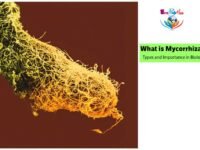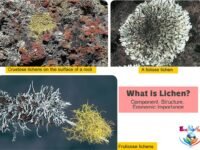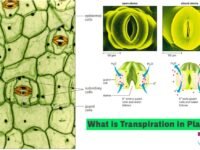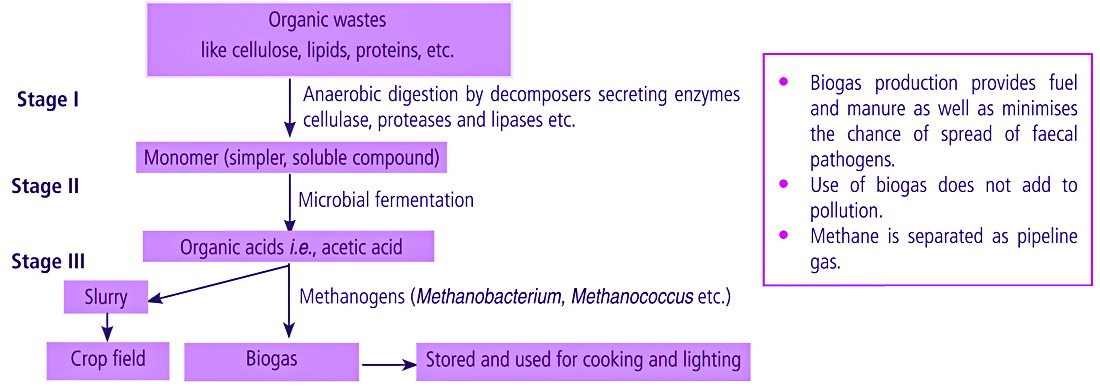In this tutorial, we have discussed ‘Role of Microbes in Human Welfare‘.
TABLE OF CONTENTS
WHAT ARE MICROBES
— Microbes or microorganisms are those organisms that are not visible to the naked eye and can be observed only with the aid of a microscope because they have a size of 0.1 mm or less.
— Microbes belong to diverse groups of organisms, including bacteria, fungi, protozoa, and microscopic plants. Viruses, viroids, and prions are also included amongst microbes.
— Viruses (nucleoprotein entities), viroids (nucleic acids entities), prions (proteinaceous entities) can only be grown inside cells while microbes like bacteria and fungi can be grown in colonies on specific nutrient media (known as ‘culture media‘, consisting of various nutrients and hormones). The colonies can be seen with naked eyes.
— Microbes are omnipresent i.e., they are found in the soil, mud, water, air, inside and outside the body of other organisms, food products, clothes, shoes, optical instruments, nails, skin, etc. They may occur even at places where no other organism can possibly exist, e.g., inside thermal vents or geysers with temperature 100°C, under several meters of thick snow where the temperature is several degrees below 0°C, highly saline or extremely acidic environment, etc.
— Microorganisms influence humans in several ways. Microbes are known to cause various diseases in man and other organisms and for deteriorating food, clothing, furniture, machinery, etc. But some of their activities are useful for us. Such activities include antibiotic production, production of dairy products and fermented beverages, sewage treatment, agriculture, and making several industrial products.
► Read More: What is Mycorrhizae? Types and Importance in Biology ► Read More: What is Lichen? Component, Structure, Economic Importance ► Read More: What is Parthenocarpy and what is Parthenogenesis? ► Read More: What is Polyembryony and its Significance in Plants
MICROBES IN HOUSEHOLD PRODUCTS
In our household, we use a variety of microbes or products obtained from them. Curd, cheese, bread, etc., which are part of our daily lives, are obtained by microbial activity.
■ DAIRY PRODUCTS
Dairy products include curd, yoghurt, butter milk, cheese, etc.
i. Curd
The starter or inoculum used in preparation of milk products containing millions of lactic acid bacteria (LAB) like Lactobacillus are added to skimmed or cream milk at a temperature of about 40°C or less. They convert the lactose sugar of milk into lactic acid. Lactic acid causes coagulation of milk protein casein and that is how milk is changed into curd.
Besides the conversion of milk into lactic acid, the LAB also improves its nutritional quality by increasing vitamin B12. Curd is more nutritious than milk as it contains a number of vitamins and organic acids. LAB present in curd also checks growth of disease causing microbes in stomach and other parts of the digestive tract. Indian curd is used either as such or in other forms such as mattha, chhach or lassi.
ii. Yoghurt
Yoghurt is produced by curdling milk with the help of Streptococcus thermophilus and Lactobacillus bulgaricus by maintaining temperature at about 45oC for 4 hours.
iii. Butter Milk
Butter milk is an acidulated product that is formed by inoculating skimmed milk with a starter culture of Streptococcus cremoris, S. lactis, Lactobacillus acidophilus, Leuconostoc species at 22°C for 18 hours.
iv. Sour Cream
— Streptococcus lactis is inoculated into the cream obtained by churning of milk to produce lactic acid.
— The characteristic flavour is introduced by adding Leuconostoc cremoris.
v. Cheese
— Curd is separated from liquid part (whey) to form cheese.
— The name cheese is derived from the Latin name caseus.
— Cheese is known to be the oldest food item in which microbes are used. There are two groups of cheese, fresh or unripened cheese and ripened cheese. The unripened cheese is made up of milk coagulated by acid or high heat e.g., cottage cheese, while ripened cheese is made through lactic acid bacterial fermentation and coagulated by an enzyme preparation.
— A large number of microorganisms play a role in the ripening process and different varieties of cheese are obtained depending upon the microorganisms used in production. The CO2 producing culture of Propionibacterium sharmanii is essential for giving Swiss cheese its eye or large holes, and flavour. Roquefort cheese uses Penicillium roqueforti while Camembert cheese employs Penicillium camemberti for ripening.
— Depending upon water content, cheese may be soft (50-80% water), semi hard (45% water) and hard (<40% water).
➢ Soft cheese is ripened by the enzymes from yeast and other fungi that grow on the surface.
➢ Hard cheese is ripened by lactic acid bacteria which grows throughout the cheese, die, autolyze and release hydrolytic enzymes.
➢ Semisoft cheese is ripened by proteolytic and lipolytic organisms which soften the curd and give it a flavour.
■ DOUGH FOR MAKING FOOD ITEMS
— Numerous food items such as ‘dosa’, ‘idli’, ‘jalebi’ and ‘bread’ are prepared by fermentation process in which one or more kinds of microbes are used.
— Dosa, uppma, and idli are fermented preparation of rice and black gram. The ‘dough’ which is used for making dosa and idli is allowed to ferment overnight for 10 to 12 hours. The bacteria, which come from atmosphere (particularly Leuconostoc mesenteroides, Streptococcus faecalis) cause fermentation so that the dough increases in volume and gets sour. Increase in the volume of dough is due to carbon dioxide gas (CO2) that is released as a result of fermentation.
— Bread is made from flour obtained by grinding cereal grain usually wheat. Selected strains of Saccharomyces cerevisiae grown on molasses are used as baker’s yeast. A small quantity of yeast is added to wheat flour and kneaded. The kneaded flour is kept at a warm temperature for a few hours. It swells up. The phenomenon is called leavening.
Leavening is caused by the secretion of three types of enzymes by yeast. They are amylase, maltase, and zymase. Amylase causes the breakdown of a small quantity of starch into maltose sugar. Maltase converts maltose into glucose. Glucose is acted upon by zymase. Zymase is a complex of several enzymes of anaerobic respiration which brings about fermentation.
Fermentation of glucose mainly forms ethyl alcohol and carbon dioxide. These two cause swelling or leavening of dough. The leavened dough is baked. Both carbon dioxide and ethyl alcohol evaporate making the bread porous and soft.
■ SINGLE CELL PROTEINS (SCP)
A relatively new food source is single cell protein (SCP). Its production began in the late 1960s. The term refers to protein obtained from the large scale growth of microorganisms such as bacteria, yeasts and other fungi, and algae.
The protein may be used for human consumption or animal feed. It may also be a useful source of minerals, vitamins, fats, and carbohydrates.
The common SCP are obtained from Spirulina, yeast, and Fusarium graminearum. SCP is rich in high quality protein but poor in fat.
■ OTHER HOUSEHOLD PRODUCTS
— Coconut water is fermented to produce a refreshing drink called toddy. It is a traditional drink in some parts of Southern India. The term toddy is also applied to sweet exudation got by tapping unopened spadix of coconut. Palm sugar or jaggery is produced by boiling it. The exudation is rich in natural yeasts which bring about its rapid fermentation to produce an intoxicating alcoholic drink.
— Arrack is obtained by distillation of fermented toddy. If allowed to ferment for more than 24 hours, toddy becomes unpalatable as alcohol is changed to vinegar.
— Microbes are also used to ferment fish, soybean, and bamboo shoots to make foods. The most popular type of fermented food is produced from soybeans called tempeh kedele (Indonesia). It is important source of vitamin B12. Tofu (Japanese) and sofu (Chinese) are also obtained from soybeans.
— Soy sauce is brown flavoured.
— Sauerkraut is prepared from fermentation of cabbage by bacteria.
MICROBES IN INDUSTRIAL PRODUCTS
— Microbes are used to synthesize a number of industrial products for human use.
— Industrial scale production requires very large vessels/containers called fermentor or bioreactor to grow microbes.
— Alcoholic beverages and antibiotics are two common industrial products obtained by microbes.
■ FERMENTED BEVERAGES
— Yeast species used in alcoholic fermentation are Saccharomyces cerevisiae (brewer’s yeast), Saccharomyces ellipsoidens (wine yeast), Saccharomyces sake (sake yeast) and Saccharomyces pireformis (ginger beer/ale yeast).
— The nutrient medium is barley malt for beer, fermented rye malt for gin, fermented rice for sake, cashew-apple for fenny, potato for vodka, fermented cereals for whisky, fermented molasses for rum and fermented juices for wines and brandy.
The yeasts are basically of two types — baker’s yeast and brewer’s yeast. The selected strains of Saccharomyces cerevisiae, used in baking industry to bring about desired changes in flavour and texture of the baked products, are sold as baker’s yeast. They are available in the form of powder or cakes. The yeasts, which are used in the brewing industry for the preparation of alcoholic drinks, are collectively called brewer’s yeast.
— Different kinds of alcoholic beverages are produced by using different brewer’s yeast and the fermenting medium. Beer and wine are undistilled beverages whereas whisky, rum, gin, brandy, vodka and fenny are distilled beverages. Distilled beverages are called ‘hard liquors’ as they contain higher percentage of alcohol.
— Beer (3-6% alcohol) is an undistilled product of grain-mesh fermentation brought about by Saccharomyces cerevisiae and S. carlsbergensis. Wine (9-12% alcohol) is an undistilled product of fruit-juice fermentation brought about by Saccharomyces ellipsoideus.
— Fermentation can be done using three different methods:
(i) Batch culture
In the batch culture, the conditions are set up and not changed from outside once the fermentation starts; for example, no more nutrients are added. This is why the process is described as a closed system. The process is stopped once sufficient product has been formed. The contents of the fermenter are then removed, the product isolated, the microorganism discarded and the fermenter is cleaned and set up for a fresh batch.
(ii) Continuous culture
Continuous culture involves continuous long-term operation over many weeks, during which nutrient medium is added as fast as it is used, and the overflow is harvested. Although this is closer to the situation in natural environments, such as the gut, continuous culture has found only limited application. However, it is used for the production of single cell protein where a large biomass of cells is required.
(iii) Fed batch culture
This is a compromise between the two systems. With fed-batch culture more control of the process is involved than with batch culture. The period of growth is extended by adding nutrients at low concentrations during the fermentation, and not adding all the nutrients at the beginning. One advantage of this is that the rate of growth can be regulated to keep pace with the rate at which oxygen can be supplied. The process is commonly used to produce yeast cells for the baking industry.
■ ANTIBIOTICS
— The term ‘antibiotics’ was coined by Waksman (1942). Antibiotics (Fr. anti = against; bios = life) are chemical substances secreted by some microorganisms which inhibit the growth and development of other microbes. Antibiotics are obtained from eubacteria, fungi and actinomycetes. Most of them are produced by actinomycetes, specially the genus Streptomyces.
— The study of antibiotics began by the discovery of penicillin in 1929, when Alexander Fleming proved that the filtrate of a broth culture of Penicillium notatum has antibacterial properties in relation to Gram-positive bacteria. In 1940, Ernest Chain and Howard Florey commercially extracted a relatively stable preparation of penicillin. The chemical was extensively used in treating wounded American soldiers in world war II. Fleming, Chain and Florey were awarded Nobel Prize in 1945. Waksman and Woodruff isolated actinomycin in 1941 and streptothricin in 1942.
Waksman and Albert (1943) and Waksman (1944) discovered streptomycin. Burkholder (1947) isolated chloromycetin. Over 7000 antibiotics are known.
— Antibiotics can be broad spectrum or specific. Broad spectrum antibiotics can kill or destroy a number of pathogens that belong to different groups whereas specific antibiotoics are effective only against one type of pathogen.
— Antibiotics function either as bactericides (kill bacteria) or bacteriostatic (inhibit the growth of bacteria) by any of these methods:
(i) Disruption of cell wall synthesis.
(ii) Inhibition of 30S and 50S ribosome functioning.
(iii) Disruption of synthesis and repair of plasmalemma.
(iv) Inhibition of aa-tRNA binding to ribosome.
(v) Inhibition of translation.
— The resistance of pathogen to existing antibiotics is generally produced due to extrachromosomal genes present in plasmids. They can pass from one bacterium to another due to transformation and transduction. As a result of repeated transformation, certain strains of bacteria have become multiresistant or superbugs, e.g., MDR (multidrug resistant).
— Production of Antibiotics
Various steps involved in the production of an antibiotic have been summarized in the table given below.
— Characteristics of Good Antibiotics
 TABLE: Some Antibiotics obtained from Microbes with their action
TABLE: Some Antibiotics obtained from Microbes with their action
■ BIOACTIVE MOLECULES
| Bioactive Molecules | Microbes | Uses |
| (i) Cyclosporin – A | Fungi: Trichoderma polysporum | It is an 11-membered cyclic oligopeptide.
(i) Anti-fungal, anti-inflammatory and immunosuppressive properties. (ii) This chemical is used as an immunosuppressive agent in organ transplantation by inhibiting T-cell activation. |
| (ii) Statin | Yeast: Monascus purpureus. | (i) Inhibit cholesterol synthesis. |
■ ORGANIC ACIDS
Microbes are also used for commercial and industrial production of certain organic acids. The first organic acid produced through microbial fermentation was lactic acid (Scheele, 1789). Some other common organic acids produced through microbial activity are acetic acid, citric acid and butyric acid.
► Acetic acid
There are mainly two steps in acetic acid or vinegar production. In the first stage yeast converts sugar into ethanol anaerobically while in the second step ethanol is oxidised to acetic acid aerobically by Acetobacter aceti. This process is called acetification. This organic acid is employed in pharmaceuticals, colouring agents, insecticides, plastics, vinegar production etc.
► Citric acid
Citric acid is obtained through the fermentation carried out by Aspergillus niger and Mucor species on sugary syrups. Yeast can also be employed, provided its nutrient medium is made deficient of iron and manganese. Citric acid is employed in dyeing, engraving, medicines, inks, flavouring and preservation of food and candies.
► Lactic acid
Lactic acid fermentation is carried out by both bacteria (e.g., Streptococcus lactis, Lactobacillus species) and fungi (e.g., Rhizopus). It is used in confectionery, fruit juices, pickles, canned food, etc.
► Butyric acid
Clostridium acetobutylicum is the bacteria that is used for production of butyric acid. It is used as food and perfume additives.
| Organic Acids | Microbes | Uses |
| (i) Acetic acid | Bacteria: Acetobacter aceti | Vinegar production, employed in pharmaceuticals, colouring agents, insecticides, plastics, etc. |
| (ii) Citric acid | Bacteria: Aspergillus niger, Mucor;
Yeast: Candida lipolytica |
Dyeing, inks, flavouring and preservation of food and candies. etc. |
| (iii) Lactic acid | Bacteria: Streptococcus lactis, Lactobacillus;
Fungi: Rhizopus |
Used in confectionery, fruit juices, pickles, canned food, etc. |
| (iv) Butyric acid | Bacteria: Clostridium acetobutylicum | Food and perfume additives |
■ ENZYMES
Enzymes are proteinaceous substances of biological origin which are capable of catalysing biochemical reactions without themselves undergoing any change.
| Enzyme | Microbes | Functions |
| (i) Proteases | Aspergillus and Bacillus species | (i) Clearing beer and whisky.
(ii) Softening of bread and meat. (iii) Manufacturing liquid glue. |
| (ii) Amylase | Aspergillus, Rhizopus and Bacillus species
|
(i) Production of alcoholic beverages from starchy materials.
(ii) Clearing turbidity in juices caused by starch |
| (iii) Streptokinase (Tissue Plasminogen Activator) |
Streptococcus | It has fibrinolytic effect. Therefore, it helps in clearing blood clots inside blood vessels through dissolution of intravascular fibrin. |
| (iv) Pectinases | Byssochlamys fulva | (i) Clearing of fruit juices.
(ii) Retting of fibres. (iii) Preparation of green coffee. |
| (v) Lipases | Candida lipolytica,
Geotrichum candidum |
(i) Added in detergents for removing oily stains from laundry.
(ii) Used in flavouring cheese. |
MICROBES IN SEWAGE TREATMENT
— Sewage is waste water having food residues, animal and human excreta, detergents, discharges from commercial and industrial establishments and pathogenic microbes etc.
— Sewage poses many harmful effects such as:
➢ It results in the dissemination of water-borne diseases caused by microorganisms.
➢ It may cause depletion of dissolved oxygen in water. Reduction in oxygen availability may kill aerobic Aquatic Organisms.
➢ Untreated sewage produces an offensive odour.
Thus sewage treatment is essential for reducing harms done by it. Whenever untreated sewage is disposed into natural waters such as
BOD represents the amount of dissolved oxygen that would be consumed if all the organic matter in one litre of water were oxidised by microorganism (at 20°C). It is an indicator of water quality. Thus, high value of Biochemical Oxygen Demand (BOD) means the water is highly polluted by organic matter. Low value of BOD means the water is either normal or less polluted by organic matter.
— Sewage water can be purified by passing it through sewage treatment plants with the action of heterotrophic microorganisms. A sewage treatment plant separates solids from liquids by physical processes and purifies the liquid by biological processes.
There are three stages of this treatment:
➢ Primary treatment (Physical treatment)
➢ Secondary treatment (Biological treatment)
➢ Tertiary treatment (Chemical treatment)
■ PRIMARY TREATMENT
— It removes floating and suspended solids from sewage through two processes: filtration and sedimentation.
First, floating matter is removed through sequential filtration with small pore filter progressively. The filtrate is kept in large open settling tanks where grit (sand, silt, small pebbles) settles down.
— The sediment is called primary sludge while the supernatant is called effluent. The primary sludge traps a lot of microbes and debris. It is subjected to composting or land fill where anaerobic digestion removes the organic matter.
■ SECONDARY TREATMENT
— There are several methods of secondary treatment, e.g., oxidation tanks, trickling filter, and activated sludge system.
— In activated sludge system, the primary effluent is taken to aeration tanks. A large number of aerobic heterotrophic microbes grow in the aeration tank. They form flocs. Flocs are masses of bacteria held together by slime and fungal filaments to form mesh like structures. The microbes digest a lot of organic matter, converting it into microbial biomass and releasing a lot of minerals.
— As the BOD of the waste matter is reduced to 10-15% of raw sewage, it is passed into settling tank. Thus secondary treatment is more or less biological. The sediment of settling tank is called activated sludge. A part of it is used as inoculum in aeration tank. The remaining is passed into a large tank called anaerobic sludge digester.
— Anaerobic microbes digest the organic mass as well as aerobic microbes of the sludge.They are of two types, nonmethanogenic and methanogenic.
— Methanogenic bacteria produce a mixture of gases containing methane, H2S and CO2. The mixture called biogas is inflammable and is a source of energy. The spent sludge can be used as manure or part of compost.
— Finally the treated sewage effluent is subjected to chemical treatment for disinfection before releasing it into natural water bodies like rivers and streams.
➢ Before 1985 very few cities and towns had sewage treatment plants. ➢ The municipal waste water was discharged directly into rivers resulting in their pollution and high incidence of water borne diseases. ➢ In order to protect the major rivers of India from sewage pollution, the Ministry of Environment and Forests, has initiated the development of sewage treatment plants under the National River Conservation Authority, e.g., Ganga Action Plan (GAP), Yamuna Action Plan, Sutlej Action Plan, Gomti Action Plan etc.
■ TERTIARY TREATMENT
— Tertiary treatment is usually not employed except where necessary. It further purifies the effluent of secondary treatment before discharging it into water bodies.
— Chlorination is performed inside the chlorine contact tank to eliminate pathogens like bacteria and viruses. Concerns about harmful disinfection by-products led to replacing chlorination with UV radiation treatment or ozonation.
— Tertiary treatment is particularly important for the removal of nitrogen and phosphorus compounds from water. It is an expensive step of treatment.


MICROBES IN PRODUCTION OF BIOGAS
■ WHAT IS BIOGAS?
Biogas is a methane rich fuel gas produced by anaerobic breakdown or digestion of biomass with the help of methanogenic bacteria or methanogens. Methanobacterium, Methanococcus are common methanogenic bacteria. Biogas is used as fuel for cooking and lighting.
■ BIOGAS COMPOSITION
Biogas is made up of
● Methane (CH4) — 50-70%
● Carbon dioxide (CO2) — 30-40%
● Traces of nitrogen (N2), hydrogen sulphide (H2S) and hydrogen (H2).
Methane is the major component of biogas. 50% of the combustible energy present in the organic waste can be changed into methane gas. The energy released from biogas depends upon the proportion of methane present in it. The calorific value of biogas is 23-28 MJ/m3.
■ BIOGAS GENERATION
As the biogas production is an anaerobic process, it is carried out in an air tight, closed cylindrical concrete tank called a digester. The tank has a concrete inlet basin on one side for feeding fresh cattle dung. There is a concrete outlet on the outer side for removing the digested sludge. The top of the tank serves as the gas tank. It has an outlet pipe for the biogas.
Biogas generation is the three-stage anaerobic digestion of animal and other organic wastes. The organic wastes consist of lignin, cellulose, hemicellulose, lipids and proteins. Lignin cannot be broken down under anaerobic conditions.
► STAGE I : SOLUBILISATION
Cellulose digestion is slower than that of other substances. In the first stage of anaerobic digestion (solubilisation), facultative anaerobic decomposer microbes bring about the enzymatic breakdown of complex organic compounds into simpler and soluble compounds often called ‘monomers’. For this, the decomposer microbes secrete cellulases, proteases and lipases (cellulolytic, proteolytic and lipolytic enzymes).
► STAGE II : ACIDOGENESIS
In the second stage (acidogenesis), the simple soluble compounds of microbial digestion or monomers are acted upon by fermentation causing microbes. Microbes change the monomers into organic acids (Lactate, Butyrate, Propionate, Ethanol).
► STAGE III : METHANOGENESIS
Organic acids, especially acetic acid, are acted upon by methanogenic bacteria in the third or final stage (methanogenesis). The methane bacteria convert organic acids as well as carbon dioxide into methane. The biogas thus formed is stored in tanks for supply.
The technology of biogas production was developed in India by the collaboration of the Indian Agriculture Research Institute (IARI) and Khadi and Village Industries Commission (KVIC).
■ ADVANTAGES OF BIOGAS
Using organic wastes first for biogas generation has the following advantages over their direct use as fuel or fertilizer:
(i) It provides both energy and manure.
(ii) Biogas has wider applications than the direct burning of organic wastes.
(iii) The energy value of biogas is lower than that of organic matter but due to more efficient handling, the net energy output is roughly equal to the output in direct burning of organic wastes.
(iv) Minimizes the chances of spread of faecal pathogens.
(v) The fertiliser value of the manure produced in biogas plants is similar to that of manure formed directly from organic wastes.
(vi) Biogas use does not add to pollution.
MICROBES AS BIOCONTROL AGENTS
— Chemical pesticides were used in agricultural land to give protection to plant crops by killing or removing pathogens and pests. But despite of being advantageous, there are various disadvantages of chemical herbicides:
— The natural method of pest and pathogen control involving use of viruses, bacteria and other insects (which are their natural predators and pests) is called biocontrol or biological control.
— For example, Lady bird beetle (beetle with red and black markings) feeds on aphids while dragonflies prey upon mosquitoes. Free living fungus Trichoderma exerts biocontrol over several plant pathogens.
— Baculoviruses (mostly of genus Nucleopolyhedrovirus) are useful in controlling many insects and other arthropods. They are species specific narrow spectrum bioinsecticides. There is no side effect on plants, mammals, birds, fish and nontarget insects. Beneficial insects are conserved. Baculoviruses are, therefore, an important component of integrated pest management (IPM) programme and is dealing with ecologically sensitive areas.
— Biocontrol agents are preferred over chemical methods of pest and disease control because:
➢ They do not eradicate pests and pathogens, but keep their levels manageable. Eradication of pests is undesirable because some beneficial predators and parasitic organisms which depend upon eradicated species for food would also be annihilated.
➢ They are non-toxic and non-biocidal.
➢ They do not kill useful organisms and do not pollute soil, fruits and vegetables.
➢They do not pose threat of developing resistant pest and pathogen varieties on continuous use of pesticides.
■ BIOPESTICIDES
— Biopesticides are those biological agents that are used for the control of weeds, insects and pathogens.
— Microorganisms like viruses, bacteria, fungi, protozoa are used as biopesticides.
— Most important example is the soil bacterium, Bacillus thuringiensis (Bt). Spores of this bacterium possess the insecticidal Cry protein. Therefore, spores of this bacterium kill larvae of certain insects.
— The commercial preparations of B. thuringiensis contain a mixture of spores, Cry protein and an inert carrier. This bacterium was the first biopesticide to be used on a commercial scale in the world, and is the first biopesticide being produced on a commercial scale in India.
Biopesticides are of two types : bioherbicides and bioinsecticides.
(01) Bioherbicides
Herbicides are chemicals that are used for inhibiting the growth of plants in unwanted places. Herbicides used for controlling weeds in the cultivated areas are called weedicide.
A number of risks are involved in the use of chemical herbicides. This can be avoided if herbicide resistance can be introduced in the crop plants. It is possible through genetic engineering or recombinant DNA technology. Transgenic Tomato and Tobacco plants have been developed which show tolerance to specific herbicides.
Certain crop plants do not allow the weeds to grow nearby. They are called smoother crops, e.g., Barley, rye, Sorghum, Millet, Sweet clover, Alfalfa, Soybean, sunflower.
Another way of weed control is the introduction of specific insects which feed on the weeds. Extensive growth of Opuntia in India and Australia was checked through the introduction of its natural herbivore, cochineal insect (Cactoblastis cactorum).
Similarly, growth of Hypericum perforatum of Klamath weed was checked by U.S.A. through the introduction of Chrysolina beetles.
● Definition: Bioherbicide is an organism that controls or destroys unwanted plant growth without harming useful plants. These are the compounds that are derived from microbes such as fungi, bacteria, phytotoxic plant residues etc. Bioherbicide based on a fungus is called mycoherbicide. The first effective bioherbicide was mycoherbicide (a fungus which destroys weeds) developed in 1981. The herbicide is Phytophthora palmivora which controls the growth of milkweed vines in citrus orchards.
Growth of Eichhornia crassipes (Water Hyacinth) is being controlled by Cercospora rodmanii in USA and Alternaria eichhorniae in India.
Puccinia chondrilla has controlled the growth of skeleton weed, Chondrilla juncea in Australia.
Fungal spores are now available to be sprayed over weeds for their elimination. Two of them are ‘Devine‘ and ‘Collego‘. The spores are ideal for marketing because they can tolerate adverse conditions and can remain viable for long periods.
(02) Bioinsecticides
Bioinsecticides are those biological agents that are used to control harmful insects. They include
➢ Predators
➢ Parasites and pathogens
➢ Natural insecticides
(i) Predators
— Destructive insects or plant pests can be brought under control through the introduction of their natural predators.
— The predators should be specific and unable to harm the useful insects. Introduction of ladybugs (Lady Bird Beetles and Praying Mantis has been successful in combating scale insects or aphids which feed on plant sap.
(ii) Parasites and Pathogens
— This is alternate biological control of plant pests through the search of their natural parasites and pathogen. They include viruses, bacteria, fungi and insect parasitoids.
— Parasitoids are organisms that live as parasites for some time (as early or larval stage) and free living at other times, e.g., Trichogramma.
— Nucleopolyhedrovirus (NPV) are species specific. For example, Baculovirus heliothis (a virus) can control cotton bollworm (Heliothis zea). Similarly, Bacillus thuringiensis (a bacterium) is effective against the cabbage looper (Trichoplusiani) and Entomophthora ignobilis (a fungus) the green peach aphid of Potato (Myzus persicae).
— In U.S.S.R. the fungus Beauveria bassiana has been successfully employed in controlling potato beetle and codling moth.
(iii) Natural insecticides
Natural insecticides are insecticides and related pesticides which are obtained from microbes and plants. A number of natural insecticides are available. The common ones include
— Azadirachtin from Margosa or Neem (Azadirachta indica).
— Rotenones obtained from the roots of Derris elliptica and Lonchocarpus nicou are powerful insecticides that are harmless to warm blooded animals.
— Squill, the red variety of Sea Onion (Red Squill, Ureginea maritima) produces a radicide that does not have any harmful effect on other animals.
— Nicotine obtained from Nicotiana species. The purified chemical is highly poisonous. Nicotine sulphate is one of the most toxic insecticide.
— Pyrethrum, an insecticide obtained from the inflorescence of Chrysanthemum cinerarifolium (Dalmation pyrethrum), C. coccineum, C. marshallii. The active compounds are pyrethrin and cinerin. Pyrethrin is also used in fly sprays, aerosols, mosquito coils, etc.
— Thurioside, a toxin produced by bacterium Bacillus thuringiensis. The toxin is highly effective against different groups of insects like moths, flies, mosquitoes and beetles.
— Transgenic plants are crop plants that are modified through genetic engineering to develop natural resistance to insects.
➢ Phytophthora palmivora – Controls growth of milkweed vine ➢ Cercospora rodmanii – Controls growth of Eichhornia crassipes ➢ Praying Mantis – Successful in combating scale insect ➢ Beauveria bassiana – Successfully employed in controlling potato beetle ➢ Rodolia cardinalis – Controls cottony cushion scale (Icerya purchasi) ➢ Cyrtorhinus mundulus – Controls sugarcane leaf hopper
MICROBES AS BIOFERTILISERS
— Chemical fertilisers are being used in increasing amounts in order to increase output in high yielding varieties of crop plants. However, chemical fertilisers cause pollution of water bodies as well as ground water, besides getting stored in crop plants. Therefore, environmentalists are pressing for switch over to organic farming. Organic farming is the raising of unpolluted crops through the use of manures, biofertilisers and biocontrol agents (discussed above) that provide optimum nutrients to crop plants, keeping pests and pathogens under control.
■ MANURES
— Manures are partially decomposed organic materials added to the soil to increase the fertility of soil and productivity of crops. They contain almost all the essential nutrients required by the plants.
— The manures are of three types: (i) farmyard manure, (ii) compost and (iii) green manure.
(01) Farmyard Manure
— Farmyard manure is the oldest manure known to mankind. It is made up of dung of farm animals, urine, farm refuse and crop residues (plant remains) which are allowed to partial decay with the help of soil microorganisms.
— The manure loosens the soil, increases its aeration and makes the soil more fertile.
— The residue of the gobar gas plant is a kind of farmyard manure.
(02) Compost
— It is a kind of manure that is prepared by degrading the dung of farm animals, crop residues, farm wastes and other organic debris (arranged in layers) in specially designed pits for the desired period of time.
— It takes about 6-8 months to prepare the compost.
(03) Green Manure
— During the preparation of green manure, many leguminous and non-leguminous crops are grown in the field and ploughed back into the soil while they are still young and green.
— This practice is as old as agriculture itself and used to enrich nitrogen, phosphorus, calcium, sulphur and other mineral content of the soil.
— Apart from supplying nutritional requirements, green manuring reduces alkalinity, prevents leaching and soil erosion. It is estimated that green manures enhance crop yield by 30 to 50 %.
— The most commonly used green manures in India are: Crotolaria juncea (sun hemp), Sesbania aculeata (Dhaincha), Cyamopsis tetragonoloba (Cluster bean), Melilotus parviflora (Sweet clover), Vigna sinensis (Cowpea or Lobia), Macrotyloma uniflorum (Horse-gram), Trifolium alexandrianum (Egyptian clover or Berseem), Lens esculenta (Lentil or Masur), Indigofera teysmanni, Cassia tora, Ipomoea carnea, etc.
■ BIOFERTILISERS
— Definition: Biofertilisers are microorganisms that bring about nutrient enrichment of soil by enhancing the availability of nutrients like nitrogen and phosphorus to crops. The microorganisms which act as biofertilisers are bacteria, cyanobacteria (blue-green algae) and mycorrhizal fungi. Bacteria and cyanobacteria have the property of nitrogen fixation while mycorrhizal fungi preferentially withdraw minerals from organic matter for the plant with which they are associated.
— Some of the important biofertilisers recommended for use in agriculture are as follows:
(01) Microphos Biofertilisers
They release phosphate from bound and insoluble states, e.g., Bacillus polymyxa, Pseudomonas striata, Aspergillus species.
(02) Free Living Nitrogen Fixing Bacteria
Free-living nitrogen fixing bacteria fix atmospheric nitrogen in the soil and make it available for the higher plants. The best example is Azotobacter.
Apart from Azotobacter, about 25 genera of free living soil enhabiting bacteria such as Clostridium, Bacillus polymyxa, Beijerinckia , Klebsiella, Derxia and Rhodospirillum are also known to fix atmospheric nitrogen. •
Inoculation of soil with these bacteria helps in increasing yield and saving of nitrogen fertilisers. For example, Azotobacter occurring in fields of cotton, maize, jowar and rice, not only increase yield but also saves nitrogen fertiliser to the tune of 10–25 kg/ha. Its inoculation is available under the trade name of azotobactrin.
(03) Symbiotic Nitrogen Fixing Bacteria
They form a mutually beneficial association with the plants, The most important of the symbiotic nitrogen fixing bacteria is Rhizobium (pl. Rhizobia). The bacteria Rhizobium occurs freely in the soil but fails to fix nitrogen in the free state. It multiplies as soon as it gets to rhizosphere of leguminous plants, enters into their roots and forms specialised structures called root nodules. The bacteria fix atmospheric nitrogen only in the root nodules and that too when present in the bacteroid forms.
Bacteroids in nodule cells are surrounded by a membrane of the host lined by red-pink pigment, leghaemoglobin, which acts as an oxygen scavenger.
The genus Rhizobium includes many species and each species further includes many strains. It has been observed that a specific strain of Rhizobium sp. gets symbiotically associated with specific species of leguminous plant, e.g., Rhizobium
leguminosarum (in pea), R. meliloti (in alfalfa), R. trifolii (in clover), R. phaseoli (in beans), R. lupini (in lupines) and R. japonicum (in soybeans), etc. Therefore, it is important to apply specific strain of Rhizobium to a particular leguminous crop in order to get maximum advantage. Frankia, a nitrogen-fixing mycelial bacterium (actinomycete), is associated symbiotically with the root nodules of several nonlegume plants like Casuarina, Alnus (alder), Myrica, Rubus, etc.
(04) Loose Association of Nitrogen Fixing Bacteria
Certain nitrogen fixing bacteria like Azospirillum live around the roots of higher plants without developing any intimate relationship. It is often called rhizosphere association.
The bacteria obtain some plant exudate and use the same as part of their food requirements. The bacteria fix nitrogen and exude a part of the fixed nitrogen for use by the plant. The phenomenon is termed associative mutualism or associative symbiosis.
(05) Free Living Nitrogen Fixing Cyanobacteria
A number of free living cyanobacteria or blue-green algae have the property of nitrogen fixation, e.g., Anabaena, Nostoc, Aulosira, Totypothrix, Cylindrospermum, Stigonema.
Aulosira fertilissima is considered to be the most active nitrogen fixer of rice fields in India (Aiyer et al, 1972). Cylindrospermum licheniforme grows in sugarcane and maize fields.
Cyanobacteria are extremely low cost biofertilisers.
(06) Symbiotic Nitrogen Fixing Cyanobacteria
Nitrogen fixing cyanobacteria (blue-green algae) form symbiotic associations with several plants, e.g., cycad roots, lichens, liverworts, Azolla (fern).
Azolla-Anabaena association is of great importance to agriculture.
Anabaena azollae resides in the leaf cavities of the fern Azolla where it fixes nitrogen. A part of the fixed nitrogen is excreted in the cavities and becomes available to the fern. The decaying fern plants release the same for utilization of the rice plants. When the field is dried at the time of harvesting, the fern functions as the green manure, decomposing and enriching the field for the next crop.
(07) Mycorrhiza
It is a mutually beneficial or symbiotic association of a fungus with the root of a higher plant. The most common fungal partners of mycorrhiza are Glomus species.
Depending upon the residence of the fungus, mycorrhizae are of two types– ectomycorrhiza and endomycorrhiza.
► Read More: What is Mycorrhizae? Types and Importance in Biology
— In ectomycorrhiza the fungal mycelium completely encloses the feeder rootlets forming sheath or mantle. The hyphae penetrate the intercellular spaces of the root cortex to form a network, called the ‘Hartig net’. The mantle of fungal hyphae increases the absorptive surface of roots and hence serve a better intake of nutrients such as nitrogen, phosphorus, calcium and potassium from the surrounding soil.
Ectomycorrhizae are known to occur in several genera such as Pinus, Quercus, Betula, Alnus, Salix, Populus etc.
The major functions, which ectomycorrhizae perform, are
➢ Absorption of water;
➢ Solubilisation of complex organic molecules into simple inorganic nutrients, their absorption and transfer to the roots; and
➢ Protection of plants from the attack of disease-inciting pathogens by secreting antimicrobial substance.
— In endomycorrhiza fungus does not form an external sheath of mantle. The fungus mostly lives in the intercellular spaces as well as intracellularly in the cortical cells of roots. Only a small portion of fungus lives outside the root. Such type of mycorrhizal association occurs in the roots of grasses, cereals, legumes, rubber, tea, tobacco, soybean, citrus and in many orchids (Neottia, Vanilla, Galeola, Epipogon, etc.).
Most of the orchids are dependent on fungi in the seedling stage for their carbon requirement.
The fungal mycelium penetrates the cortical cells of orchid roots and forms nutrient rich hyphal coils, generally called peletons. These peletons degenerate and supply the orchid with carbohydrates and other nutrients obtained from the outside.
One of the important types of endomycorrhizae is vesicular-arbuscular mycorrhizae (VAM). In this association, the fungal mycelium forms some special kinds of organs, called vesicles and arbuscules, within the root cortical cells. They serve as the food storage organs of the fungus. Endomycorrhizae stimulate the absorption of phosphorus, zinc, copper, sulphur, potassium and various other elements by roots. They secrete antimicrobial substances to protect the plants from pathogen attack.
The various importance of biofertilisers are given below: (i) They increase the yield of plants by 15–35%. (ii) Biofertilisers are effective even under semi-arid conditions. (iii) Farmers can prepare the inoculum themselves. (iv) Biofertilisers do not allow pathogens to flourish. (v) They improve soil texture. (vi) They produce vitamins and growth promoting biochemicals.



























